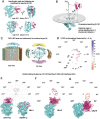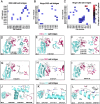This is a preprint.
Nuclear receptor interdomain communication is mediated by the hinge with ligand specificity
- PMID: 38405809
- PMCID: PMC10888817
- DOI: 10.1101/2024.02.10.579785
Nuclear receptor interdomain communication is mediated by the hinge with ligand specificity
Update in
-
Nuclear Receptor Interdomain Communication is Mediated by the Hinge with Ligand Specificity.J Mol Biol. 2024 Nov 15;436(22):168805. doi: 10.1016/j.jmb.2024.168805. Epub 2024 Sep 25. J Mol Biol. 2024. PMID: 39332668
Abstract
Nuclear receptors are ligand-induced transcription factors that bind directly to target genes and regulate their expression. Ligand binding initiates conformational changes that propagate to other domains, allosterically regulating their activity. The nature of this interdomain communication in nuclear receptors is poorly understood, largely owing to the difficulty of experimentally characterizing full-length structures. We have applied computational modeling approaches to describe and study the structure of the full length farnesoid X receptor (FXR), approximated by the DNA binding domain (DBD) and ligand binding domain (LBD) connected by the flexible hinge region. Using extended molecular dynamics simulations (> 10 microseconds) and enhanced sampling simulations, we provide evidence that ligands selectively induce domain rearrangement, leading to interdomain contact. We use protein-protein interaction assays to provide experimental evidence of these interactions, identifying a critical role of the hinge in mediating interdomain contact. Our results illuminate previously unknown aspects of interdomain communication in FXR and provide a framework to enable characterization of other full length nuclear receptors.
Figures





Similar articles
-
Nuclear Receptor Interdomain Communication is Mediated by the Hinge with Ligand Specificity.J Mol Biol. 2024 Nov 15;436(22):168805. doi: 10.1016/j.jmb.2024.168805. Epub 2024 Sep 25. J Mol Biol. 2024. PMID: 39332668
-
Simulations reveal unique roles for the FXR hinge in the FXR-RXR nuclear receptor heterodimer.bioRxiv [Preprint]. 2024 Oct 10:2024.05.29.596427. doi: 10.1101/2024.05.29.596427. bioRxiv. 2024. Update in: ACS Bio Med Chem Au. 2024 Nov 27;5(1):194-203. doi: 10.1021/acsbiomedchemau.4c00105. PMID: 38854087 Free PMC article. Updated. Preprint.
-
Simulations Reveal Unique Roles for the FXR Hinge in the FXR-RXR Nuclear Receptor Heterodimer.ACS Bio Med Chem Au. 2024 Nov 27;5(1):194-203. doi: 10.1021/acsbiomedchemau.4c00105. eCollection 2025 Feb 19. ACS Bio Med Chem Au. 2024. PMID: 39990948 Free PMC article.
-
Full-length nuclear receptor allosteric regulation.J Lipid Res. 2023 Aug;64(8):100406. doi: 10.1016/j.jlr.2023.100406. Epub 2023 Jun 24. J Lipid Res. 2023. PMID: 37356665 Free PMC article. Review.
-
Bile acid nuclear receptor FXR and digestive system diseases.Acta Pharm Sin B. 2015 Mar;5(2):135-44. doi: 10.1016/j.apsb.2015.01.004. Epub 2015 Feb 25. Acta Pharm Sin B. 2015. PMID: 26579439 Free PMC article. Review.
References
-
- Lou X., Toresson G., Benod C., Suh J.H., Philips K.J., Webb P., and Gustafsson J.A., “Structure of the retinoid X receptor α-liver X receptor β (RXRα-LXRβ) heterodimer on DNA,” Nat Struct Mol Biol 21(3), 277–281 (2014). - PubMed
Publication types
Grants and funding
LinkOut - more resources
Full Text Sources
